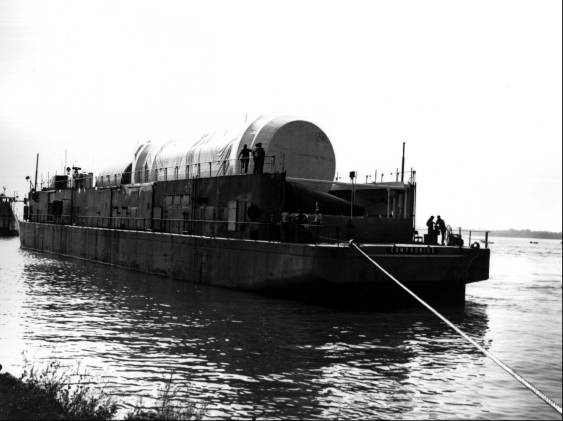
Two years earlier Marshall Flight Center officials had decided to transport the Saturn booster (SA-1's only live stage) from Huntsville to Cape Canaveral by water. In April 1961, Test Division personnel loaded a waterballasted tank, the approximate size and weight of the booster, and a dummy upper stage aboard the barge Palaemon. The barge, resembling a Quonset hut on a raft, made the first leg of its trial trip in five days, descending the Tennessee, Ohio, and Mississippi Rivers to New Orleans. There, a seagoing tug replaced the river tug. The Palaemon crossed the Gulf of Mexico to the Florida Keys, sailed through the straits, and up the Atlantic coast via the Intracoastal Waterway. The LOD team on the Saturn dock, located at the south end of the Cape industrial area, witnessed a strange sight when the simulated booster emerged from the Palaemon's hatch. The big spoked rings, 4.3 meters across, on each end of the 25 x 2. 1-meter tank, looked like the wheels and axle of a gigantic vehicle. The simulation served its purpose, proving that both the Palaemon and the Cape's secondary roadways could carry the load.18
The Palaemon was undergoing modifications back at Huntsville in early June when the lock at Wheeler Dam, Tennessee, collapsed, stranding the barge upriver. Test Division and LOD personnel moved quickly to secure a reserve barge from the Navy's mothballed fleet at Green Cove Springs, Florida. Although there was not enough time to construct a cover for the second barge, the Avondale Shipyards at Harvey, Louisiana, made emergency modifications. Concurrently, the Tennessee Valley Authority enlisted the Corps of Engineers to build a bypass road and dock at Wheeler Dam. The Navy had identified its drab barge by a number, YFNB33. NASA rechristened the vessel Compromise, in hopes it would prove a workable one.19

The Compromise at Wheeler Dam, 5 August 1961, with SA-1 onboard.
The booster was ready for shipment in early August, following static firing and two months' further testing at Redstone Arsenal. To protect the booster during its voyage, the Test Division installed humidity and pressure regulating equipment within the LOX and RP-1 systems. Protective covers were placed on each end of the booster, as well as on the dummy upper stage and payload. After the assembled booster, with its support cradles, connecting trusses, and assembly rings, was jacked onto two axle-and-wheel units, an M-26 Army tank retriever towed the load to Redstone's dock. Marshall engineers had provided for the Tennessee River's three-meter fluctuation at the arsenal by building special ballasting characteristics into the Palaemon.20
The portage at Wheeler Dam, the reloading on the Compromise, and the journey to New Orleans went smoothly. Out in the Gulf of Mexico, however, the ten-man crew had rough sailing. Test Director Karl L. Heimburg attributed the handling problems to the Compromise's insufficient ballast. Negotiating the Intracoastal Waterway proved even more difficult, and the Compromise went aground four times. Heimburg blamed this on unreliable channel depths due to the shifting of the loose, sandy bottom. Crosswinds were an additional hazard; besides threatening to blow the barge around, the wind caused several near-accidents at bridges. (The Compromise was to collide with a bridge on the return trip, causing minor damage.) Despite Heimburg's frustrations, the SA-1 arrived unscathed at the Cape's Saturn dock on the 15th.21
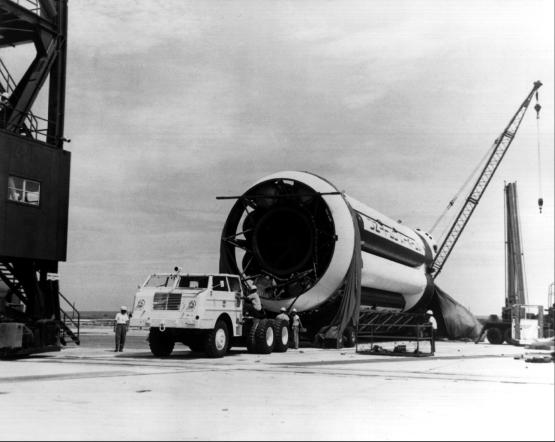
Transporting SA-1 to the pad.
Unloading the booster was relatively easy in the almost tideless Banana River. Henry Crunk's vehicle-handling unit towed the S-1 transporter across the Cape at a majestic 6.5 kilometers per hour. Although the operation required little physical exertion, the ten-man team perspired freely on the treeless Cape. At pad 34 ocean breezes made the heat and glare more tolerable. Most visitors, associating Florida's beaches with leisure, would have found the mixed sounds of service structure cranes and pounding surf incongruous. The novelty for LOD veterans lay in the huge Saturn booster, which had at last arrived at its action station.22
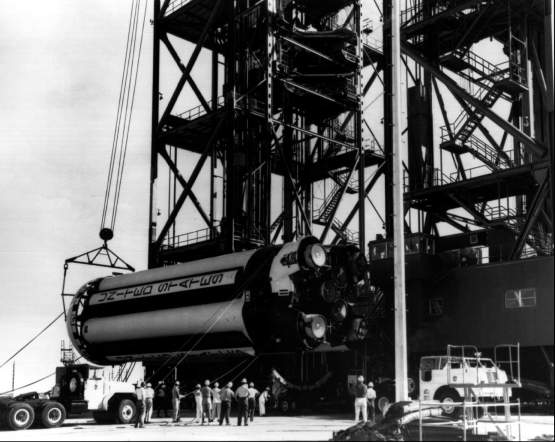
Lifting the first stage from the transporter.
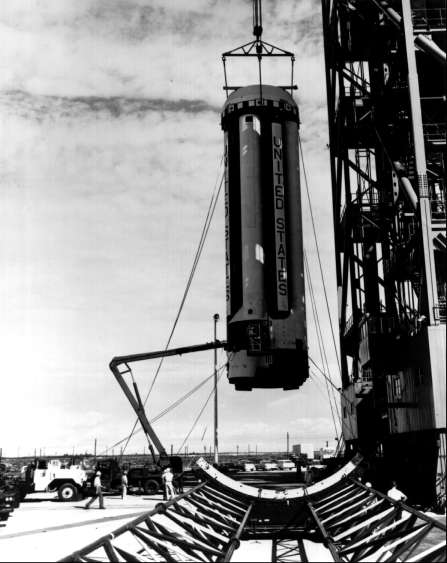
Hoisting the stage in vertical attitude.
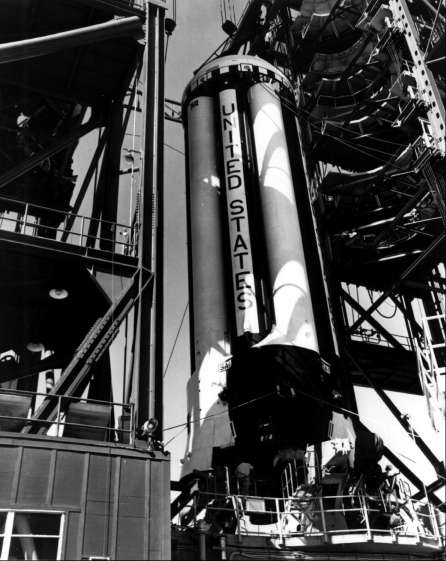
Setting the first stage on the support arms at LC-34.
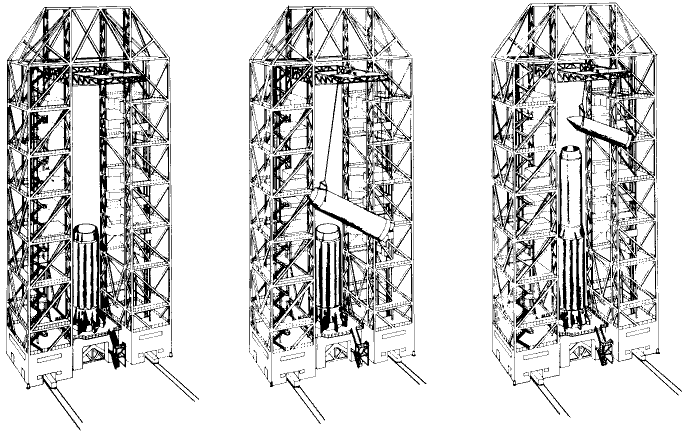
Erecting the upper stages.
The booster or S-1 stage was erected on Sunday, 20 August. Crunk's unit had practiced maneuvering a dummy tank on the pad, but this was the first mating of the booster to the launch pedestal. With the service structure in place over the pedestal, an M-26 driver positioned the transporter parallel to the service structure base. The crew connected crane hooks to pickup points on the booster, a 60-ton hook to the forward sling and a 40-ton hook to the thrust frame sling. The crane operator raised the S-1 stage vertically, brought it into the service structure, and lowered it onto four preleveled support arms. Removal of the transportation assembly rings proved the most time-consuming aspect of an uneventful operation. Early the following week, Crunk's unit hauled the dummy stages and payload from hangar D, where they had undergone inspection. The handling unit mated the dummy stages and the nose cone on the 23rd. Cables and cable masts were installed, the four retractable support arms positioned, and network power applied on the 25th. Concurrently the Fabrication Division installed exhaust duct brackets, access doors, and the radio frequency shield.23
20. MSFC, SA-1 Vehicle Data Book, pp. 123-30.


